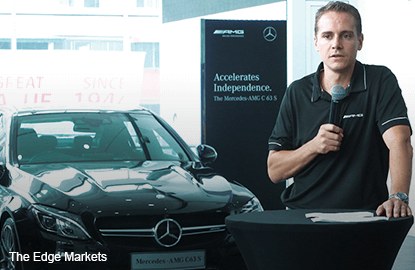
This article first appeared in The Edge Malaysia Weekly, on October 5 - 11, 2015.
 WHILE the wider automotive industry may be falling into a rut, Mercedes-Benz is bucking the trend with more than 8,000 units sold to date — a year-on-year increase of over 60%.
WHILE the wider automotive industry may be falling into a rut, Mercedes-Benz is bucking the trend with more than 8,000 units sold to date — a year-on-year increase of over 60%.
More importantly, the sales volume looks to be sustainable, says Mercedes-Benz Malaysia Sdn Bhd (MBM) vice-president of sales and marketing Mark Raine.
“I am very confident about our sales because of the level of bookings we have been receiving. Our market share has grown to 1.9% and I believe this is a fair share of the market. It is in line with our global market share, which is also 1.9%,” Raine tells The Edge at the launch of the new Mercedes-AMG C 63 last week.
MBM will be announcing its September sales on Thursday and Raine says it will be another month of four-figure sales. For the eight months ended Aug 31, Mercedes-Benz sold over 7,400 units, up 64% y-o-y. In contrast, BMW only managed about 4,500 units in the same period — a 12% decline.
Raine attributes the strong sales performance to the line-up of new models — such as the A-Class, C-Class, S400 Hybrid and E300 BlueTEC Hybrid — that were steadily launched over the past year.
If this is the new normal for Mercedes-Benz’s sales, dealers Cycle & Carriage Bintang Bhd (CCB) and Hap Seng Consolidated Bhd will be the key beneficiaries.
Naturally, CCB (fundamental: 2.10; valuation: 1.10), as a pure automotive play, would benefit more than Hap Seng Automotive sales only makes up 3.6% of Hap Seng’s operating profit.
Unlike its peers, CCB isn’t just a dealer for Mercedes-Benz. The company has a 49% stake in MBM, which gives it exposure to the wholesale distribution of the marque in Malaysia. Mercedes-Benz’s parent company, Daimler AG, controls the remaining 51%.
For the cumulative six months ended June 30, CCB posted a net profit of RM28.47 million, an increase of 663% from RM3.73 million in the previous corresponding period. Revenue rose 76% y-o-y to RM735.48 million.
CCB attributed the performance to the strong sales of popular models, improved margins and recognition of dividend income from MBM.
On a trailing 12-month basis, CCB is trading at 7.7 times earnings based on last Friday’s closing price of RM2.68. In contrast, German-listed Daimler is valued at around 8.6 times earnings.
It is important to note, however, that Mercedes-Benz’s sales have not been fully captured in the trailing 12 months net profit, which stands at RM35.07 million. On an annualised basis, this year’s six months of net profits works out to be RM56.94 million. Based on this, CCB is only valued at 4.7 times earnings.
With a waiting period of up to six months — depending on the model and the customer’s specifications — there should not be a problem for Mercedes-Benz to sustain its sales momentum to the end of the year. The waiting period used to be longer but MBM has stepped up its production in Pekan — for the S-Class, for example — to meet demand.
Raine shrugs off concerns that the depreciating ringgit — which has fallen 20% against the euro in the past 12 months — would put a squeeze on margins.
“There is no margin pressure. We plan our hedging very carefully and are confident that margins will not be affected in the mid-term — 6 to 12 months. Our dealers’ margins will not be affected either,” says Raine, who refrained from sharing details about MBM’s hedging strategy.
Note that the dealers transact in ringgit terms with the distributor, hence MBM is fully protected from currency fluctuations.
A price hike, however, is not on the cards at the moment.
“We price according to the value for the customer. For the short to mid-term, we see no need to increase prices. There are other levers that we can use before we consider raising prices,” he explains.
However, if the ringgit continues to depreciate drastically, these assumptions would have to be revised, admits Raine.
Unlike other marques with lacklustre sales, Mercedes-Benz has not had to be as aggressive in terms of offering extended warranties. Moving forward, this will help protect its after-sales margins.
Meanwhile, Mercedes-Benz’s dealer network will continue to expand over the next 12 months with “a number of new showrooms in the pipeline”, says Raine. After all, when dealers are profitable, they will reinvest in the business and expand the reach of the dealership network. In contrast, it is understood that Sime Darby Bhd, which is the largest dealer for BMW, has put its expansion plans on hold amid falling sales.
As a brand, this puts Mercedes-Benz in a good position. Not only has it gained market share but it will also be in a better position to compete with rival marques with more and better equipped showrooms.
MBM is also planning to invest RM100 million over the next five years to expand and improve its local production capacity. Presently, the C-Class, E-Class and S-Class are manufactured in Pekan, Pahang, via a collaboration with DRB-Hicom Bhd. Completely knocked down (CKD) vehicles make up an estimated 70% of sales in the country.
With the popularity of the A-Class, MBM could also localise the compact hatchback — a possibility that MBM is studying at the moment, says Raine.
Note: The Edge Research’s fundamental score reflects a company’s profitability and balance sheet strength, calculated based on historical numbers. The valuation score determines if a stock is attractively valued or not, also based on historical numbers. A score of 3 suggests strong fundamentals and attractive valuations. Visit www.theedgemarkets.com for more details on a company’s financial dashboard.
Save by subscribing to us for your print and/or digital copy.
P/S: The Edge is also available on Apple's AppStore and Androids' Google Play.